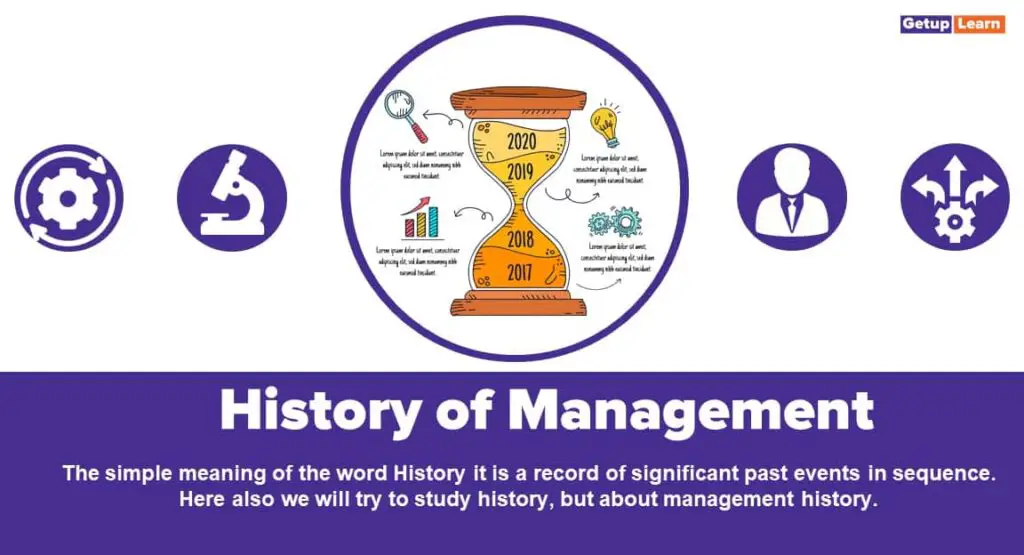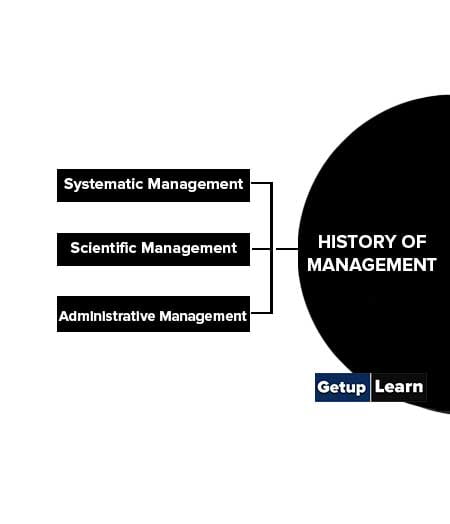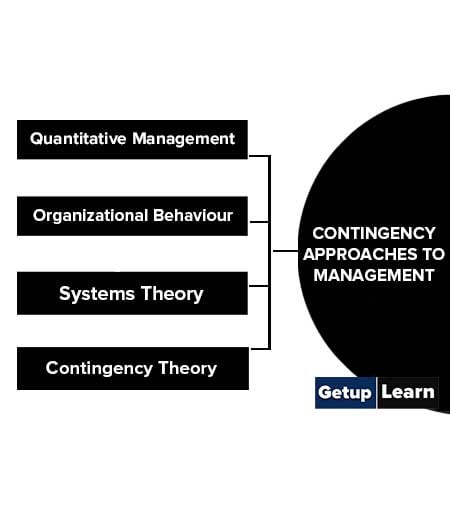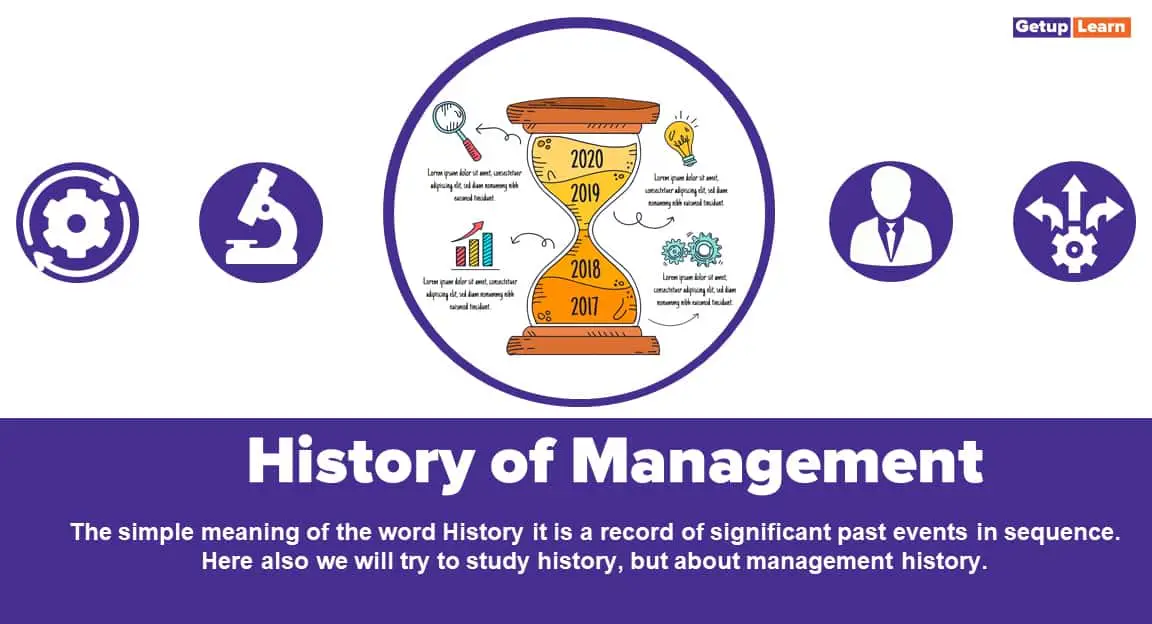The simple meaning of the word History it is a record of significant past events in sequence. Here also we will try to study history, but about management history. The reasons behind the study of management history are:
- To get an idea about how today’s organizations are evolved.
- To learn about the mistakes done in past and do necessary corrections in the future.
- To understand how different theories are developed.

In the case of the study of management history here, the most important reason is the third one, i.e. to understand how different management theories are developed. This history of management is also known as the Evolution of Management Thought or what Bateman and Snell have called it “Revolution of Management.” If we look back in history, around 1100 B.C. the Chinese practiced the four management functions planning, organizing, leading, and controlling.
Between 350 B.C. and 400 B.C., the Greeks recognized management as a separate art and advocated a scientific approach to work. Before the birth of Christ, the Romans decentralized the management of their huge empire and many such developments had taken place in those days.
Two historical management concepts:
There are two important concepts required to be understood as a part of early management concepts in history. They are the Division of labor and Economies of scale. Division of labor means dividing the jobs into small parts and doing it as a repetitive activity.
This can give lots of economic advantages to the organization. This concept was argued by Adam Smith in his book The Wealth of Nations in 1776. Economies of scale mean when the total volume of production increases, the average cost of a product reduces.
This concept came into the picture at the time of the industrial revolution, where the industrial revolution means the advent of machine power, mass production, and efficient transportation.
Below that we will understand the history of management.
Table of Contents
Classical Approaches to Management
In classical approaches to management, major contribution has come from the systematic approach, scientific management, administrative management, human relations, and bureaucracy. In the contingency approach, quantitative management, organizational behavior, systems theory and contingency theory, and theory Z are part of it.
Now first let us discuss classical approaches to management:

Systematic Management
In the 19th century, most of the businesses in the manufacturing industry were suffer- ing from poor coordination among subordinates and different level management problems disturbing the manufacturing process.
In this situation, systematic management mainly focused on internal operations, like – economical operations, adequate staffing, maintenance of inventories to meet consumer demand, and organizational control. These goals were achieved through:
- Clear definition of duties and responsibilities.
- Standardized techniques for performing these duties.
- Specific means for gathering, handling, transmitting, and analyzing information.
- Cost accounting, wage, and production control systems to facilitate internal coordination and communication.
Scientific Management
Systematic management failed to lead to widespread production efficiency. To work in this direction, a second approach was introduced by an engineer named Frederick W. Taylor, also known as the father of scientific management.
This scientific approach has focused on the scientific way to analyze work and determine how to complete production tasks efficiently.
Taylor identified four principles of scientific management:
- Analyze the work using scientific methods to determine ‘one best way’ to complete production tasks.
- Management should scientifically select, train, teach and develop each worker so the right person has the right job.
- Heartily cooperate with the workers and assure that all work is in harmony with the principles of science.
- Divide the work and responsibility equally between workers and management and management should take that work, which is more suitable to them than the workers.
Administrative Management
Limitations of scientific management have led to the development of administrative management. Henry Fayol is a major contributor to administrative management. When Taylor wrote a book, he also wrote but the focus areas were different.
Taylor has more focused on first-line managers and the scientific method, whereas Fayol has written about all management. Fayol wrote from his personal experience because he was a director of a large French coal-mining firm.
Fayol said that management practice is very different from other accounting, finance, production, distribution, and other typical business functions. He believed that management activity is required in all human efforts, like business, government, and even at home and he has given 14 fundamental rules as a fundamental rules of management. They are:
- Division of Work: A person with a specialization in work, can perform more efficiently.
- Authority: To get the work done by others. Managers need authority, which means they must have the right to take decisions and give orders.
- Discipline: Employees must obey and respect the rules of the organization, or else should punish violations.
- Unity of Command: Every employee must receive orders from one superior only, otherwise it can create confusion and conflict among people.
- Unity of Direction: Organizations should have a single plan of action to guide managers and workers to achieve organizational objectives.
- Subordination of Individual Interest to General Interest: The interest of the organization should have dominance and priority, not the interest of an individual or a group.
- Remuneration: There should be a systematic and fair remuneration pattern for employees and employers.
- Centralization: Decreasing the role of subordinates in decision-making is centralization and increasing their role is centralization. Fayol said that determining the relative importance of superior and subordinate roles needs to balance the authority between them.
- Scalar Chain: The line of authority from top management to the lowest ranks is the scalar chain, which must be followed in communication and work.
- Order: People and materials should be at the right place and at the right time for smooth functioning and waste of material in the organization.
- Equity: Managers should be kind and fair to their subordinates.
- Stability of Tenure of Personnel: An organization must take steps to obtain as much stability in its management and workforce as possible.
- Initiative: Employees should be encouraged to contribute new ideas and experiences in the work assigned to them.
- Esprit De Corps: Promoting team spirit will build harmony and unity within the organizations.
Other than Henry Fayol, Max Weber has also contributed to administrative management, specifically to the area known as “bureaucracy which emphasizes a strictly defined hierarchy governed by clearly defined regulations and lines of authority.
Contingency Approaches to Management
These are the following contingency approaches to management which we will discuss below:

Quantitative Management
Quantitative management emphasizes the application of quantitative analysis to management decisions and problems. This approach can be helpful to management by developing formal mathematical models of the problem.
Techniques like statistical decision theory, linear programming, forecasting, breakeven analysis, and network modeling contribution to quantitative management. They are applied in different functional areas of management like production, quality control, distribution, finance, research, development, etc.
Organizational Behaviour
During the 1950s a transition took place in the human relations approach. People have felt that some other factors than the satisfaction of economic and social needs matter. At that time organizational behavior perspective emerged, which was a study of management activities that promote employee effectiveness through an understanding of the complex nature of the individual, group, and organizational processes.
Here a significant contribution is known by Douglas McGregor of Theory X and Theory Y. According to McGregor, theory X managers assume that workers are very lazy and irresponsible and require constant supervision and external motivation to achieve organizational goals and theory Y managers assume that employees want to work and can direct and control themselves.
He advocated the theory Y perspective, suggesting that managers who encourage participation and allow opportunities for individual challenge and initiative would achieve better performance.
Systems Theory
Basically, an organization is a managed system, that changes inputs (raw materials, people, and other resources) into outputs(the goods and services that comprise its products). Here, the word system is a connection of its interdependent elements or factors that work together to achieve the aim of the system.
This system is made up of many sub-systems, like its functions like marketing, finance, production, HR, etc. Apart from these functional areas, there are many other factors – individuals, groups, attitudes, motives, formal structure, interactions, goals, status, and authority also affect the system.
The term interdependent is very important here, because if the purchasing department will not purchase a sufficient quantity, then the production department will not be able to produce as per plan, Hence, it can be said that different activity of the organizational system is interlinked and interdependent.
A change in one sub-system can affect the total system. There- fore sub-systems work together towards synergy (a harmony of forces) in order to accomplish organizational goals that couldn’t have been accomplished by anyone sub-system alone, which is also presented in the form of A + B = C, here, A and B are sub-systems and alone they are less than the sum of them. i.e. – C. So, management thinkers have understood the value of every individual part of the organization, including its sub-system through this system theory.
In the system, the impact of one part on another should also be predicted, before putting it into action. In the system approach, the organization must take into consideration its external environment, because it also affects many ways of the organization’s work and decisions.
So if manager will coordinate the work activities of the various parts of the organization and see that all the interdependent parts of the organization are working together, the organizational goal can be achieved properly. Some important terms connected with system theory are:
- Open v/s Close System: An open system interacts with other systems through the free passing of information, whereas closed systems operate on their own with little or no influence from the outside world.
- Entropy: Entropy can be defined as the measure of disorder, uncertainty, and consumed energy in a system or in the Universe.
- Synergy: Synergy means that the whole is greater than the sum of its parts. For e.g. A + B = C, where the sum of C is always greater than A and B. According to system theory, it is the advantage of joining two sub-systems and getting more outcomes.
- Subsystem: Each part of a bigger system is a sub-system.
Contingency Theory
Building on system theory ideas, the contingency perspective disapproves of universal principles of management by stating that a variety of factors, both internal and external may affect the organization.
Thus, there is no “one best way” to manage and organize, because circumstances vary. E.g. a universal strategy to offer a low-cost product can not be successful in a market, where customers are not cost-conscious. Situational characteristics are called contingencies. These contingencies include:
- External Environment.
- Internal strengths and weaknesses of the organization.
- The values, goals, skills, and attitudes of managers and workers.
- Type of tasks, resources, and technologies the organization uses.
With an eye on these contingencies, a manager may categorize the situation and then choose the proper competitive strategy, organization structure, or management process for the circumstances.
What are the classical approaches to management?
The following are the classical approaches to management:
1. Systematic Management
2. Scientific Management
3. Administrative Management.
What are the contingency approaches to management?
The following are the contingency approaches to management:
1. Quantitative Management
2. Organizational Behaviour
3. Systems Theory
4. Contingency Theory.

